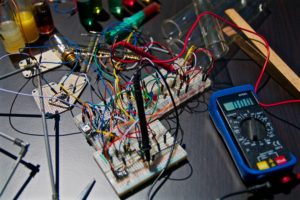STEM stands for Science, Technology, Engineering, and Math. Normally, math and science classes are taught separately and in different classrooms, by different teachers. STEM is a more integrated approach to these subjects. Math and science are used to solve real-world problems and challenge the students to see the connections and correlations in the subjects. STEM education is a more project-based way of teaching and thinking that will allow students to appreciate how all of the subjects work together.
STEAM adds arts to the mix. Arts includes everything from the humanities, language arts, dance, drama, music, visual arts, design, and new media. Changing STEM to STEAM was first recommended by the Rhode Island School of Design. They noticed that by adding arts to the mix, students who were not mathematically or technologically strong were more comfortable participating in class.
The main difference between STEM and STEAM is that STEM explicitly focuses on scientific concepts. STEAM investigates the same concepts but does this through inquiry and problem-based learning methods used in the creative process normally seen in the art classes.
Why is STEAM important?
There is an ongoing debate whether it is important to add arts to STEM. Proponents of adding arts believe that a more well-rounded education is better than a direct focus on the sciences. There is a direct correlation between the study of music and greater abilities in math. Many educators believe that by adding arts to STEM you are strengthening the student as a whole and positively impacting their math and science abilities.
There are many prominent institutions including NASA and the National Science Foundation, that promote STEM and not STEAM. Many of these organizations believe that the arts are important but have no role in STEM. Many also believe that there is a greater need for science and technology professionals than for artists.
STEAM education in schools provides students with the opportunity to learn creatively, using 21st-century skills such as problem-solving. These general capabilities are crucial to growing a future-ready workforce that understands how to solve problems that occur in real life.
Whether you support STEM or STEAM one thing is clear: young people of all backgrounds and abilities will create our future using STEM or STEAM concepts. Some of the characters that our kids are growing up with are inspiring them to move into STEM fields. How can we forget Daria and Eliza Thornberry, Sid the Science Kid, Velma from Scooby-Doo, and Lisa Simpson? All super smart STEM characters who use hard and soft skills to solve a wealth of problems.
Education Today
At a time when many are urging us to get our children back to basics through the “three Rs” of reading, writing, and arithmetic, many educators are focusing on STEM education. For educators, there is now a greater need for science, technology, engineering and maths (STEM) concepts to integrate with the arts (STEAM) across the wider curriculum.
Teachers working in STEAM settings often see their students making connections between concepts and solving problems in new and exciting ways. These groups of learners work collaboratively to create visually appealing products or objects that are based on the understanding of a STEM concept, such as the mathematics of the parabola used to create fine art imagery.
STEAM is not a new concept. Leonardo Da Vinci is an early example of someone using STEAM by combining science and art to make discoveries.
The Future of STEAM
Business and industry are constantly broadcasting that the future of employment is in science and technology. Future employees need to have multiple areas of expertise or at least appreciate how a range of skills fit together. There are lots of hands-on learning opportunities popping up in schools and institutes all over the country. These opportunities help make our kids ready for the future.
These hands-on opportunities and take many forms but many are called “maker spaces”. They encourage collaboration in learning and discovery by using science and tech resources. Here students can focus on soft circuits, embedded video, game creation, data art, and more.
The Global Movement of STEAM
STEAM is a global movement and STEAM projects fuse scientific discovery with art. Innovative research and resources like “Maker spaces” fully realize the intersections between the arts, engineering, mathematics, science, and technology, and the influence they have on each other.
With STEAM, we can challenge the preconception that learning areas are separate. This allows us to move our kids past believing that they either need to be good at science and math or at art. This new way of thinking is engaging, multifaceted and inclusive, with the diversity of representation and thought. This is how it is in the real world, after all.
Personally, I don’t think it matters if we use STEM or STEAM. Because STEM is not exclusive to just the subjects of science technology, engineering, and math. It incorporates these subjects into everyday life, it is all-inclusive. Using the technical knowledge and skills with our natural creativity, whether we include that in the classification of an actual art or not, inspires creativity in all professions. STEM or STEAM is the basis for all new technology and ideas. If we don’t continue to promote STEM education, all professions, including the Arts and Humanities will suffer.
Enjoying MommyNerdist? Sign up for our free newsletter today!







